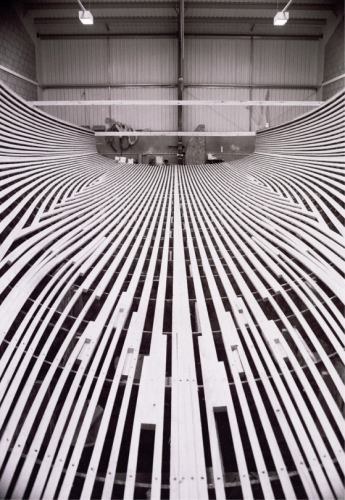
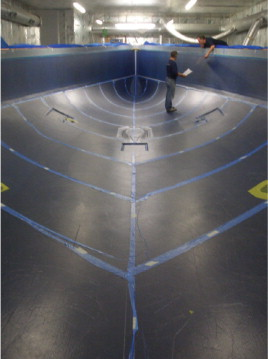
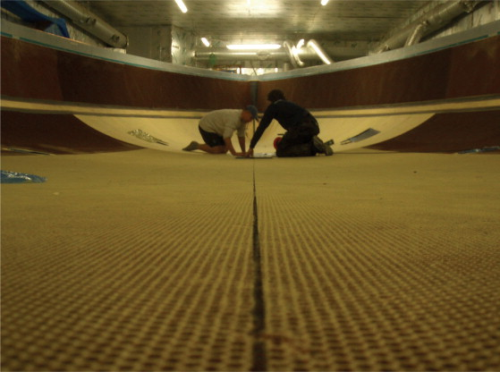
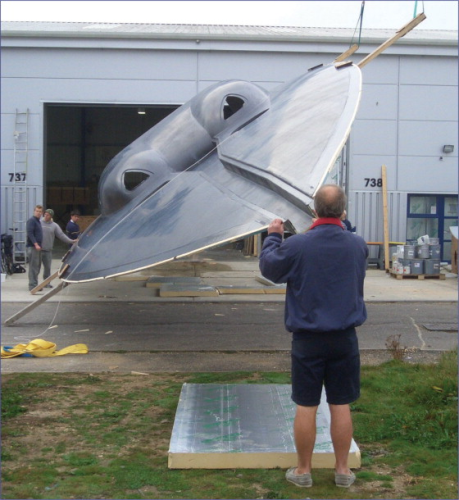
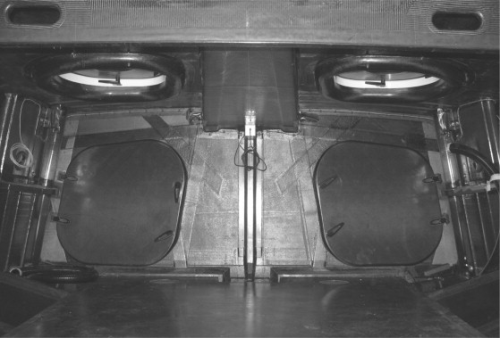
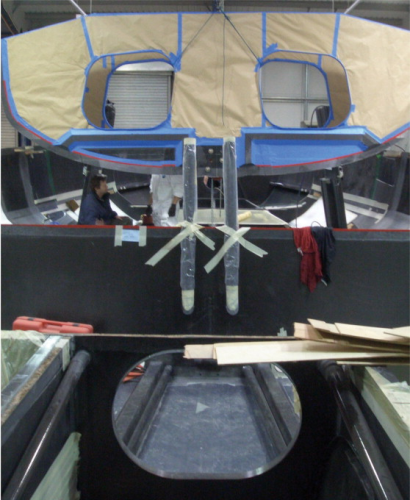
Neville Hutton is not a name with a high public profile. Yet, within a circle of the world's most competitive ocean-going yachtsmen, his name is up in lights; he is top of the bill. Whenever a newer, faster, more advanced sailboat is needed at the leading edge of sailing competition, they beat a path to his door. N. Hutton Boat Builders Ltd of Lymington, UK, thrives despite having virtually no permanent employees, hardly advertising at all and building just one major new craft per year. A large part of Hutton's ‘secret' is mastery of the processes that convert advanced composite materials into vessels that will extend the boundaries of seagoing performance.
A list of craft Neville Hutton has built reads like a roll call of race winners. Mean Machine, Innovision, Telefonica, Caixa Galicia and Patches are boat names that mean plenty to the cognoscenti, while latterly Hutton has built Hugo Boss and Artemis 2, both advanced Open 60 designs. During the three decades of its existence, N. Hutton Boat Builders has built almost 50 craft, ranging in size from the 21 ft Mini Transat Aberdeen Asset to the enormous 60 ft ‘skimming dishes' that are modern Open 60s. In between, there have been ILC40, IMS 50 and TP52 class monohulls and a Formula 40 trimaran. All except the first few have been composite.
Production methods
Hutton began his career back in the 1970s, serving a five-year shipwright apprenticeship with the Berthon Boat Company, based in his home town of Lymington. He started by making the tea and sweeping the floors, chores which – he points out wryly – still fall to him at his own works today! Working with wooden boats initially, he proved to be a perfectionist and was soon being allocated to the top projects of the day. During his last year at Berthon he independently built a quarter-ton class racer in wood.
In 1978 Hutton branched out on his own, ambitiously starting with a 54 ft Van de Stadt design, a wooden craft that he built at nearby Beaulieu. In the early 1980s he embarked on glass reinforced plastic (GRP) construction, building sprightly racers such as the Rob Humphreys designed three quarter-ton class Roller Skate. By now he knew that he enjoyed building one-off custom performance craft and that series production boats were not for him. He also knew that composites, given their combination of strength and stiffness with low weight, were a powerful means to achieve competitive edge on the water. But, for Hutton, composites were never commodity materials.
As he told Reinforced Plastics: “At no point have I turned out stock fibreglass boats [meaning chopped strand mat glass/polyester]. I have always been in at the bespoke performance end, both in terms of the boats I've built and the materials used.”
An early introduction to the West System led to an appreciation of the merits of epoxy resin, maintained ever since through a close association with Isle of Wight-based SP Systems (now part of Gurit), a company which meets most of the boat builder's needs both for materials and for composites structural engineering. Hutton was an early exponent of curing under vacuum as a means of achieving superior consolidation and properties in the cured laminate. Vacuum-bagged epoxy has remained his constructional mainstay, though he has moved away from the wet lay-up methods employed initially to the use of more production-friendly and less variable prepreg and semi-preg materials today.
The first several boats were male-moulded, though today Hutton-produced hulls and decks are laid up in female moulds, thereby avoiding the need for filling and fairing with the extra weight and labour that this involves. A number of early vessels, particularly in the 1990s, relied on Kevlar as the fibre reinforcement, a choice largely dictated by the rating rules of the time. A typical high-performance laminate of the period would be made up of four to five layers of unidirectional Kevlar/epoxy in each of two skins sandwiching a core of polyvinyl chloride (PVC) foam such as DIAB's Divinycell. However, as Hutton recalls, Kevlar was not the most production-friendly material, in particular being difficult to cut and wet out.
But by then carbon was making its presence felt, initially being used for local reinforcement of mainly Kevlar structures. A number of Kevlar-carbon one tonners were built, but since then and with changes in the rule regime, carbon has largely superseded the aramid reinforcement. This fibre provides superior performance and, as Hutton points out, does not inevitably increase vessel cost.
“Carbon, although more expensive by the square metre, is not necessarily the most expensive reinforcement in practice,” he argues. “It's easier to work with and that cuts down on labour, and because of its specific strength you might use, say, three layers of carbon either side of a core where you'd need five layers of aramid for the same structural performance. Furthermore, carbon takes less resin to wet out, so there's a saving there too.”
Laminate details are decided by the vessel designer and structural engineer, and Hutton works closely with both. Only aligned fibres are used, in unidirectionals and fabrics, and with each successive raceboat generation designers and engineers become more knowledgeable about load distributions and adept at engineering strength into specific load paths. Consequently, boats are becoming progressively lighter and more easily driven. High extension carbon is the reinforcement mainstay, though some intermediate-modulus fibres are used selectively. Hutton-built boats do not feature high-modulus carbon since the result would be too stiff and prone to fracture in a seaway.
The laminate for a typical contemporary yacht will be balanced, with up to five layers of 200 g/m2 carbon prepreg each side of a core, generally today of Nomex honeycomb rather than PVC foam. Monolithic construction, used in high-stress areas such as chainplate and other attachments, can require laminate up to 12 mm thick typically and perhaps more around the keel area.
Working from the laminate plans, Hutton will order the requisite amounts of prepreg and other materials, slightly in advance of the build process. Given the sizes of craft Hutton tends to build these days, volumes of materials ordered are considerable and this justifies a high degree of personal service from the material supplier (mainly SP). Material is bespoke, being formulated to the requirements of the boat builder/designer/engineer trio. For instance, Hutton will specify a fibre-to-resin ratio of typically 65-70%, and will require prepreg delivered complete with a glue film where appropriate. New arrivals of prepreg are carefully logged into the factory and freezer, as are details of the materials' subsequent withdrawal from cold store and use in ensuing processes.
Like other boatbuilders working at the leading edge, Hutton has benefited from continued material advances including reduction in resin cure temperate required for a given laminate strength. SP's SE70 prepreg, for instance, when cured at 70°C, yields much the same properties as previous resin generations that required an 84°C cure. This is important for one-off boatbuilders who rely on moulds built affordably from wood rather than expensive aerospace materials. Lower temperatures reduce the expiration of moisture and consequent deformation to which wooden structures can be prone.
Inside the Lymington-based three-bay factory where N. Hutton Boat Builders has been for the last 11 years, there are two Eurotherm ovens. One is a large unit able to accommodate hulls and decks up to 70 ft long; the other is dedicated to curing bulkheads and other flat items. The latter features automatic zone control of temperature, with feedback provided by numerous thermocouples, while the larger oven is manually controlled. The ovens can be heated to 120°C if required, though 70-85° is the normal working range.
A typical cure cycle for a sizeable sandwich hull or deck would involve ramping up at a third of a degree per minute to 40°C with a dwell time at that temperature of some two hours, then a further ramp up to 60°C and another two hours dwell time, followed by a third ramp up to curing temperature (normally 70-85°C), at which the item is left to cure for up to 14 hours. Hutton favours the practice of carrying out a ‘warm de-bulk' under vacuum at 30-45°C for several hours, in order to bleed off excess resin and lighten the laminate.
Materials excellence must be matched by the care and experience with which the materials are laid up and processed to form the final laminate. Hutton has no permanent shop floor staff but, in the unique application environment in which he operates, this is a strength since it frees him to employ the world's best laminators when a new build programme is due to start. Seeking out these high-skill ‘nomads', who follow the work and the seasons, is hardly a chore since, once the word of a new Hutton project is ‘out on the street', the right individuals are soon in contact and, having been engaged as self-employed tradesmen, assemble themselves into an effective working team.
Human relations is an important skill for Hutton, who must be able to manage a team of diverse talents from various parts of the world and work closely with top designers and engineers, while also meeting the needs of owners and their project managers. Fortunately most owners, no matter how influential in their own fields, are instinctively aware on walking into the construction shop that, for once, they are well down the hierarchy in terms of expertise and control!
Artemis 2
The yacht most recently built by N. Hutton Boatbuilders is the advanced IMOCA Open 60 Artemis Ocean Racing II, currently (at time of writing) out in the Atlantic with her British skipper Jonny Malbon, building up qualifying miles for the Vendee Globe single-handed world-girdling ocean race that starts this November. Though Neville Hutton was limited on what he could say about this very current yacht, due to client confidentiality, other sources have supplied additional details.
Launched in March this year, Artemis 2 was designed by Rogers Yacht Design of Lymington, in association with Jonny Malbon who would have to sail her, specifically with the Vendee Globe in mind. With beam of 6 m she is relatively wide for her 18.5 m (60 ft) length, giving her high form stability under a press of sail. She also differs from the Artemis team's previous (and existing) Open 60 Artemis 1 in having canting keels to enhance righting moment and performance to windward, and a rotatable rig - the mast with its two deck-level outrigger spreaders rotating on a joint at the mast base. In the seafaring tradition intended to ensure good luck, the mast was stepped over a coin, in this case a 2008 British gold sovereign.
The keel fin, a highly stressed item that has been subject to failure on other high-performance yachts, is of moulded stainless steel. High-tensile steel has been avoided because of problems in welding this material reliably and composites were judged not yet sufficiently proven to be adopted for this critical application. This is a yacht that has to survive a gruelling round-the-world passage, including conditions in the notorious southern ocean, away from all support facilities.
The hull and deck are of female-moulded carbon/Nomex sandwich construction. Moulded carbon/Kevlar sails, from North Sails UK, are carried on the single carbonfibre mast, which stands 28 m (90 ft) above the deck and was produced by Formula Spars. SP senior structural design engineer Luke McEwen, along with colleagues Andrew Whittaker and Francisco Santos, used advanced finite element analysis (FEA) to secure sufficient strength and stiffness in a hull that nevertheless has pushed down the Open 60 weight boundary still further so that the entire yacht displaces just 8.8 tonnes.
“FEA, along with our growing database of experience and accelerometer measurements from other vessels, has enabled us to go ‘closer to the bone' in terms of laminate specifications,” says McEwen. “We also made more use of laminate curvature and carried out further research into the high slamming loads that forward areas of the hull experience so that we could optimise the laminate there for the expected conditions. For example, we specified CoreCell [styrene acrylonitrile/SAN] structural foam core rather than Nomex for that area.”
Another focus for special attention was the area where the keel joins the hull. Tank tests and computational fluid dynamics (CFD) modelling underpinned an understanding of the complex hydrodynamic interactions so that the hull shape at this point could be optimised. The need for a rotatable fairing to accommodate movement of the canting keel added to the complexity.
Artemis 2 has five watertight bulkheads and these, particularly the critical midship bulkheads that distribute loads from the keel structure and rig, were among the most complex composite fabrications on the vessel, according to Neville Hutton. They were laid up on a flat table dedicated to the production of planar items. Among the challenges the structural and build teams had to face was skipper Jonny Malbon's desire to have larger than average openings in bulkheads and companion ways to ease his task of manoeuvring heavy sails down below in rough conditions. This involved many calculations and careful design and placing of reinforcements around the openings. Other ways in which the vessel was designed around the capabilities of the solo skipper included the provision of an ample weather-protecting coach roof/cuddy and close attention to the location of the navigation station and other working items.
The hull was moulded upright in a female mould constructed in wood and carefully faired. The outer skin and core were co-moulded together in one hit, and oven cured at 75°C. Vacuum bagging was then removed so that prepreg layers for the inner skin could be laid up and subsequently bagged and cured. Test panels prepared alongside the full-scale item as laminating progressed were sent to SP for evaluation as a quality control measure. SP's SE70 prepreg material was used, along with SP70 SPRINT for monolithic (non-cored) areas of the hull such as around the keel. Core was primarily Nomex, with selective use of CoreCell in forward hull areas. Most of the carbon was high-elongation unidirectional, along with some 0/90° woven biaxial and other fabrics.
The deck was fabricated in much the same way, in a separate bay. Main bulkheads and interior items (there is no luxury below, fit out being limited basically to a couple of bunks, a simple galley, heads and navigation station) were inserted and bonded to the hull. The deck was then added, this being bonded to a flange moulded into the upper hull.
For boat builder Neville Hutton, the main satisfaction in fulfilling commissions like Artemis 2 lie in winning the commission in the first place, and then achieving a high performing structure that is as near perfect as possible. For him, nothing else will do; he claims to hate DIY at home because of having to work under makeshift conditions with the correct tools never to hand! When interviewed by Reinforced Plastics he was not yet sure what his next commission would be but had ‘several irons in the fire' and was confident that, come October, his construction facility would be busy on an advanced race winner for next season. Once again he will be on a mission to produce yet another composites-based greyhound of the sea.






